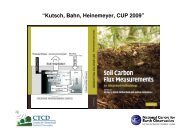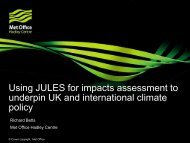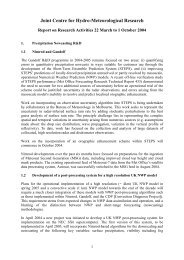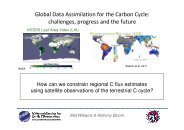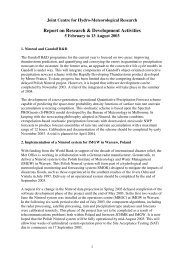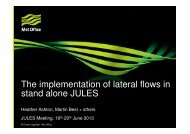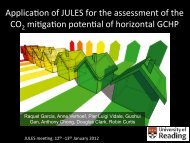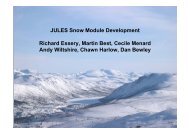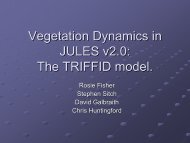Report - Joint Centre for Hydro-Meteorological Research
Report - Joint Centre for Hydro-Meteorological Research
Report - Joint Centre for Hydro-Meteorological Research
Create successful ePaper yourself
Turn your PDF publications into a flip-book with our unique Google optimized e-Paper software.
An extreme rainfall event produced flooding in Carlisle in early January 2005. Theper<strong>for</strong>mance of operational weather <strong>for</strong>ecasting systems has been studied and a preliminaryreport written. The per<strong>for</strong>mance of a Grid-to-Grid River Flow Model (RFM) which routesrunoff from Nimrod-MOSES-PDM was also studied. A rerun of Nimrod-MOSES-PDM-RFMwith a larger flow wave speed (which required a shorter timestep <strong>for</strong> the RFM) gave morerealistic magnitude and timing <strong>for</strong> the flood peak flow.A feature of recent post-event evaluation reports has been the plots of rainfall, runoff and riverflow with map backgrounds produced with a Geographical In<strong>for</strong>mation System (GIS) softwarepackage.8. Development and validation of soil state and surface hydrology models(i) CEH have compared observations from two LOCAR catchments (the Pang/Lambourn andthe Tern) with soil moisture from the operational Nimrod-MOSES-PDM during 2003. For thePang/Lambourn catchment, neutron probe data were available (at roughly <strong>for</strong>tnightly intervalsand down to depths in excess of 3 m) <strong>for</strong> the whole of 2003 but the profile data (hourlyintervals down to 1 m depth) were available from mid-summer to the end of the year. Thereport highlights (i) the difficulty of using site-specific soil moisture measurements <strong>for</strong>validating 5km x 5km model gridsquare means; (ii) the deficient soil moisture from the versionof Nimrod-MOSES-PDM which was operational in 2003 (note: the soil hydraulics andassociated ancillary fields were changed to the van Genuchten <strong>for</strong>mulation in May 2004); (iii)some problems with the radar rainfall analyses in late April to mid June 2003 and (iv) thespecial nature of water movement through chalk which isn’t represented well in MOSES.(ii) The ELDAS project (European Land Data Assimilation System to predict Floods andDroughts) is supported by the European Union in the context of the Fifth FrameworkProgramme. Scientists from the JCHMR have been involved in a case study to compare theELDAS soil hydrology to the operational data available <strong>for</strong> the Autumn 2000 floods affectingSouth East England. Soil moisture data, generated by the Tessel land-surface scheme, wereused to replace soil moisture estimates within PDM rainfall-runoff models calibrated to 3catchments within the Thames basin. It was found that the Tessel estimates of soil moisturehad to be adjusted to correspond to the soil moistures required by the PDM models. This wasdone by comparing the soil moisture from the two sources and linearly trans<strong>for</strong>ming the Tesselsoil moisture estimates. No overall advantage <strong>for</strong> flow prediction was found in using the Tesselsoil moisture (even after adjustment) over the soil moisture intrinsic to the PDM rainfall-runoffmodel. Tessel soil moisture estimates were much less variable than those from the PDM andseldom reached saturation, even during the autumn 2000 floods. This may in part be related toscaling effects. The Tessel estimates are <strong>for</strong> a 40 km grid (1600 km 2 ), and use rainfall at thisscale introducing smoothing, whilst the largest catchment modelled with the PDM was of theorder of 300 km 2 . Spatial invariance of the soil properties assumed in the Tessel land-surfacescheme may be a further contributing factor. The ELDAS project is now finished and the Final<strong>Report</strong> is available on the ELDAS web site www.knmi.nl/samenw/eldas/ .5



